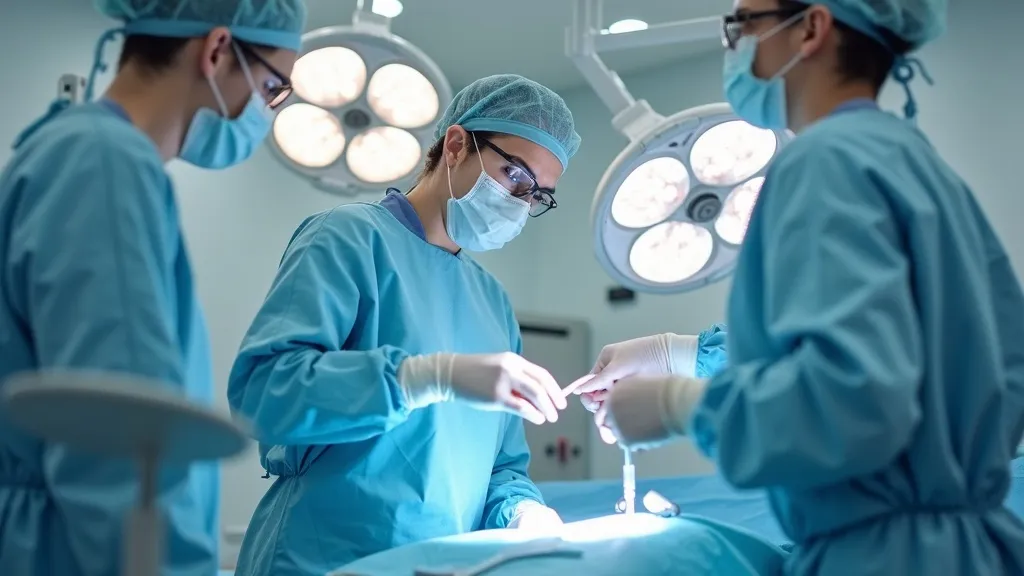Understanding Abdominoplasty and Liposuction
This article delves into the nuances of abdominoplasty and liposuction, two popular cosmetic procedures aimed at body contouring. Abdominoplasty, often known as a tummy tuck, focuses on removing excess skin and fat from the abdomen, while liposuction targets fat deposits in various body areas. Both procedures require careful consideration and consultation with a qualified surgeon to achieve desired results safely and effectively.

Introduction to Abdominoplasty and Liposuction
In the realm of cosmetic surgery, abdominoplasty and liposuction stand out as leading procedures for individuals seeking a more contoured body profile. While both surgeries aim to enhance physical appearance, they cater to different needs and outcomes. Understanding the nuances of each procedure is essential for anyone considering body contouring, as it allows for informed decision-making tailored to personal goals and health circumstances.
What is Abdominoplasty?
Abdominoplasty, commonly referred to as a tummy tuck, is a surgical procedure designed to remove excess skin and fat from the abdomen. It also tightens the abdominal muscles, offering a firmer and smoother abdominal profile. This procedure is particularly beneficial for individuals who have experienced significant weight loss or pregnancy, conditions that often leave behind loose skin and weakened muscles. The procedure not only improves aesthetics but can also enhance physical comfort and confidence.
During an abdominoplasty, a surgeon makes a horizontal incision between the pubic hairline and the belly button, allowing access to the abdominal tissues. The surgeon then removes excess skin and fat, tightens the abdominal muscles, and repositions the remaining skin for a flatter appearance. The results can be quite dramatic, leading to improved body proportions and a more youthful look.
Understanding Liposuction
Liposuction, on the other hand, is a technique used to remove localized fat deposits that are resistant to diet and exercise. It is not a weight-loss solution but rather a method to sculpt and define body contours. Liposuction can be applied to various body parts, including the thighs, hips, buttocks, abdomen, arms, and even the neck. It works by using a suction technique, where a cannula (a thin tube) is inserted through small incisions to break up and suction out fat deposits.
This procedure can lead to a more proportionate body shape and can be particularly effective for individuals who are close to their ideal weight but struggle with stubborn fat in specific areas. Depending on the extent of fat removal and the areas treated, liposuction can enhance both physical appearance and self-esteem, allowing individuals to wear clothing more confidently and participate in activities they may have previously avoided due to body image concerns.
Comparing Abdominoplasty and Liposuction
| Aspect | Abdominoplasty | Liposuction |
|---|---|---|
| Purpose | Removes excess skin and tightens muscles | Removes localized fat deposits |
| Ideal Candidates | Post-pregnancy or significant weight loss | Individuals with stubborn fat deposits |
| Recovery Time | 2 to 4 weeks | 1 to 2 weeks |
| Results | Firmer abdomen | Enhanced body contour |
| Aesthetic Goals | Improving abdominal appearance and strength | Targeting specific fat areas for contouring |
| Scarring | Significant due to larger incisions | Minimal due to small incisions |
Choosing the Right Procedure
Deciding between abdominoplasty and liposuction depends on individual goals and physical conditions. A thorough consultation with a board-certified plastic surgeon is essential to determine the most suitable approach. The surgeon will assess factors such as skin elasticity, muscle condition, and overall health to recommend the best course of action. During the consultation, patients should openly discuss their aesthetic desires, medical history, and any concerns they may have. This transparency allows the surgeon to tailor the recommendation to the patient’s unique situation.
Additionally, the surgeon may present alternative options or complementary procedures. For example, a patient seeking a flatter abdomen may benefit from both abdominoplasty and liposuction, depending on their specific needs. Understanding all available options can empower patients to make the best choices for their bodies.
Pre-Procedure Considerations
Before undergoing either procedure, patients should maintain a stable weight and ensure they are in good overall health. This includes refraining from smoking, which can impair healing, and following a healthy lifestyle with proper nutrition and exercise. It’s crucial to understand the risks involved and have realistic expectations regarding the outcomes.
Patients may also be advised to undergo preoperative assessments, which can include blood tests and medical evaluations to ensure they are suitable candidates for surgery. This proactive approach helps to minimize potential complications during and after the procedures.
Furthermore, patients should prepare their homes for recovery by arranging for assistance or taking time off work. This can involve setting up a comfortable recovery space and ensuring that necessary supplies are readily available, such as medications, compression garments, and any required medical equipment. Proper preparation can significantly ease the recovery process.
Post-Procedure Care and Recovery
Postoperative care is vital for a smooth recovery and optimal results. Patients should adhere to their surgeon’s instructions, which may include wearing compression garments, avoiding strenuous activities, and attending follow-up appointments. Compression garments help reduce swelling and support the healing process.
During recovery, it’s normal to experience some discomfort, swelling, and bruising. Surgeons typically prescribe pain management medications to ensure patient comfort. Patients should also be vigilant about monitoring their incision sites for signs of infection, such as increased redness, swelling, or discharge.
Gradually resuming normal activities is essential. While light walking is encouraged to promote circulation, patients should avoid heavy lifting or intense exercise for several weeks. Following a surgeon's guidance on when to return to regular activities can greatly impact the final results of the procedure.
FAQs
- Is liposuction a substitute for weight loss? No, liposuction is not a weight-loss solution but a body contouring procedure. It is most effective for individuals who are already near their target weight but have specific areas of fat they wish to address.
- Can abdominoplasty and liposuction be combined? Yes, these procedures can be performed together for comprehensive body contouring, depending on individual cases. Combining them can enhance results, particularly for patients with both excess skin and stubborn fat.
- How long do the results last? With a healthy lifestyle, the results of both procedures can be long-lasting. However, significant weight fluctuations can affect the outcome. Patients are encouraged to maintain a stable weight through proper diet and exercise.
- What are the risks involved? Common risks include infection, scarring, and anesthesia complications, which can be minimized with a skilled surgeon. Patients should discuss these risks during their consultation and ensure they are comfortable with the potential complications.
- What should I expect during the recovery period? Recovery experiences can vary, but common elements include swelling, bruising, and discomfort. Patients should have realistic expectations and understand that full recovery can take several weeks to months.
- Will I have visible scars after the procedures? Both procedures will result in some scarring. However, skilled surgeons take great care to place incisions in less visible areas and to minimize scarring through precise techniques. Over time, scars often fade and become less noticeable.
Conclusion
Both abdominoplasty and liposuction offer transformative results for those seeking to enhance their body contours. By understanding the differences and consulting with experienced professionals, individuals can make informed decisions to achieve their aesthetic goals safely and effectively. These procedures not only improve physical appearance but can also lead to increased self-esteem and confidence in one’s body image.
Ultimately, the journey towards body contouring is personal and can be life-changing. Whether one opts for abdominoplasty, liposuction, or a combination of both, it is essential to approach the process with clear goals, realistic expectations, and a commitment to postoperative care for the best results. With the right preparation and guidance, individuals can look forward to the positive changes that these procedures can bring to their lives.
Exploring Costs and Financial Considerations
Understanding the financial aspect of abdominoplasty and liposuction is crucial for those considering these procedures. The costs can vary significantly based on several factors, including the surgeon's experience, the complexity of the procedure, and the geographic location of the surgery. Generally, abdominoplasty tends to be more expensive than liposuction due to the complexity and time involved in the surgery.
Patients should also consider the costs of postoperative care, including follow-up visits, medications, and any necessary garments. Many plastic surgeons offer financing options or payment plans to help patients manage the financial burden. It’s essential for individuals to discuss these options during their consultation, ensuring they have a clear understanding of the overall costs involved.
Insurance coverage for these procedures is typically limited, as they are usually classified as elective surgeries. However, in some cases, if the procedure is deemed medically necessary (for instance, if excess skin causes physical discomfort or health issues), patients may be able to receive partial coverage. It’s advisable to check with insurance providers and understand the specific coverage policies related to cosmetic surgery.
Long-Term Maintenance and Lifestyle Factors
After undergoing abdominoplasty or liposuction, maintaining the results requires a commitment to a healthy lifestyle. Regular exercise and a balanced diet play crucial roles in sustaining the body contour achieved through surgery. Patients are encouraged to adopt a routine that includes cardiovascular exercise, strength training, and flexibility exercises to promote overall health and maintain their new physique.
Additionally, staying hydrated and avoiding excessive sun exposure can help preserve skin health and appearance. Monitoring weight and making adjustments to one’s diet and exercise plan as needed is also vital. Many patients find that their newfound confidence and improved body image motivate them to lead healthier, more active lifestyles.
Furthermore, support systems, such as friends, family, or support groups, can provide encouragement and accountability. Sharing experiences with others who have undergone similar procedures can be beneficial for emotional support and motivation. It’s important for patients to engage in self-care practices that promote mental well-being, as body image and self-esteem can be closely linked to overall mental health.
Potential Complications and How to Mitigate Risks
As with any surgical procedure, abdominoplasty and liposuction come with potential risks and complications. While serious complications are rare, being informed about them can help patients take appropriate precautions. Common complications include infection, hematoma (blood accumulation), seroma (fluid accumulation), and adverse reactions to anesthesia. Understanding these risks allows patients to be vigilant during the recovery process.
To mitigate risks, choosing a board-certified plastic surgeon with extensive experience in body contouring procedures is critical. Patients should thoroughly research potential surgeons, reading reviews and testimonials, and checking their credentials. During the initial consultation, patients should not hesitate to ask about the surgeon's experience, complication rates, and specific techniques used.
Additionally, following preoperative and postoperative instructions carefully can greatly reduce the likelihood of complications. This may include avoiding certain medications or supplements before surgery, adhering to guidelines for wound care, and attending all follow-up appointments to monitor healing progress.
Emotional and Psychological Impact of Body Contouring Surgery
Beyond the physical transformations that abdominoplasty and liposuction can bring, the emotional and psychological impact of these procedures is profound. Many patients report a significant boost in self-esteem and body image following surgery. The changes often lead to enhanced confidence in social situations, improved relationships, and a greater willingness to engage in activities that may have been avoided previously.
However, it’s important to recognize that body contouring surgery is not a cure-all for deeper psychological issues related to body image and self-esteem. Patients are encouraged to approach the decision for surgery with a healthy mindset, understanding their motivations and expectations. Psychological evaluations may be beneficial for some individuals to ensure they are mentally prepared for the changes that accompany surgery.
After the procedure, patients should continue to prioritize mental and emotional well-being. Engaging in activities that promote happiness, seeking support from loved ones, and possibly participating in counseling can help individuals navigate the emotional landscape post-surgery. This holistic approach ensures that the journey toward body confidence is well-rounded and sustainable.
Conclusion: Embracing Your New Self
In conclusion, both abdominoplasty and liposuction offer transformative results for those seeking to enhance their body contours and improve their self-image. By understanding the differences, benefits, and risks associated with these procedures, individuals can make informed decisions that align with their personal goals and health considerations. With proper preparation, care, and commitment to a healthy lifestyle, patients can successfully navigate their journey toward body transformation.
Ultimately, embracing one’s new self after surgery involves more than just physical changes. It encompasses a shift in mindset, a commitment to health, and a celebration of the body in its evolved state. By fostering positive self-acceptance and engaging in practices that support both physical and emotional well-being, individuals can fully enjoy the benefits of their cosmetic surgery journey and lead fulfilling lives.






